One weekend recently we decided to check out the newly unveiled habitat installations over in the Presidio. 12 projects scattered throughout the park made for a nice hike.
It was a beautiful day, one of the first warm and dry weekends of the year.
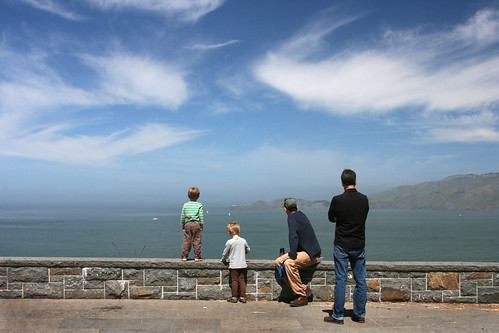
Land, sea and sky were all looking lovely that day.
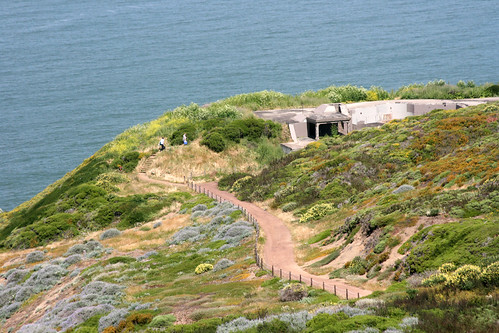
The first piece was "Where is the Hare?" by Nathan Lynch. No longer found in the Presidio, the black-tailed jackrabbit is enticed by to the park by a promise of a can't-lose race. But I'd say the black-tailed jackrabbit is already a loser in our race for space.

The next installation is a grouping of yellow chairs around a meadow. Named "Patience" by Jensen Architects, the solitary seats encourage one to become as still and silent as the hunting blue heron and through the stillness of waiting and watching, one can know the environment more.

Next up is the Buckminster Fuller house for owls by Taalman Koch Architecture, aptly named "Owl Dome". Pretty hip owl pad.

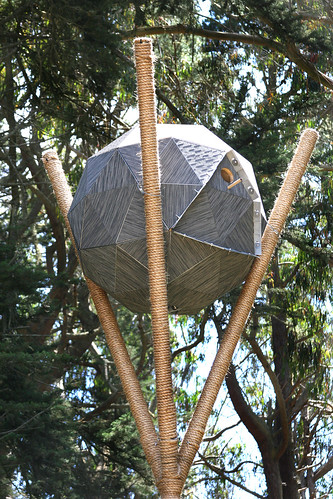
The most minimal piece was Surface Design, Inc.'s "A Habitat of Flight". A single twisting band of steel represents the flight of a hawk over a large distance. Also built to be a perch for hawks but I didn't see anything high enough or with enough of a view, to please a hawk. It was hard to photograph, it shows up best in black and white.
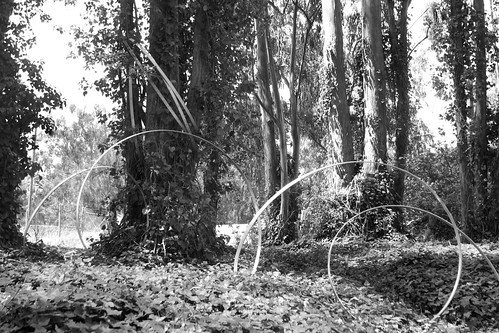
The "Sculpture Habitat for the Grey Fox" by Cebra was pretty fun. I wanted to climb on it myself. Made from felled cypress trees in the Presidio, it has a beautiful way of fitting together. I look forward to seeing this again in a few months after it has aged and blends in more with its surroundings.

My favorite piece was by far "Winged Wisdon" by Philippe Becker Design, but then, as I've said before, I'm a sucker for words in the landscape. Three phases were interwoven into a grove of trees, half camouflaged, half unmissable. The steel mesh letters were stuffed with straw that will hopefully be used by birds in nestmaking. The first phrase I came upon was "resolve conflict with song". The site was wonderfully chosen since the tree-filled dell was filled with birdsong. The other two phrases were "nest from the inside out" and "adapt to change". Can't wait to see this one age as well.
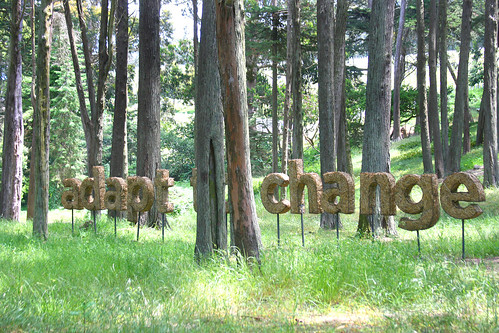
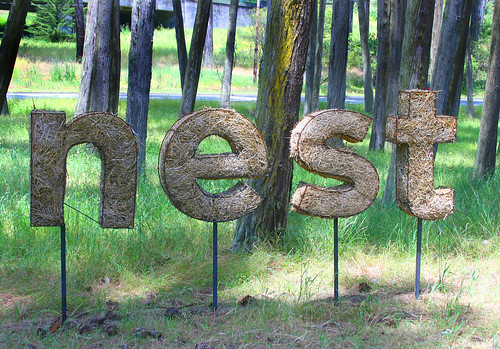
Another owl habitat sculpture was Ai Weiwei's "Western Screetch Owl Habitat". Made of porcelain, the vessels felt very precarious and delicate hanging from the trees. I just hope they had drainage holes in case anyone does decide to nest in there.
The bat barracks of Mark Dion/Nitin Jayaswal's "Winged Defense" was a great allegory to not only the Presidio's military history but also reinforces the idea of bats as protectors of humans - protecting us from mosquitoes and mosquito-born illnesses. Well done, I salute thee.
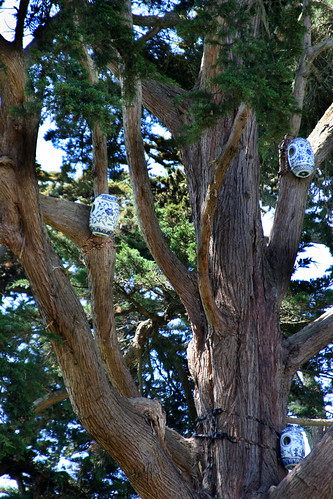
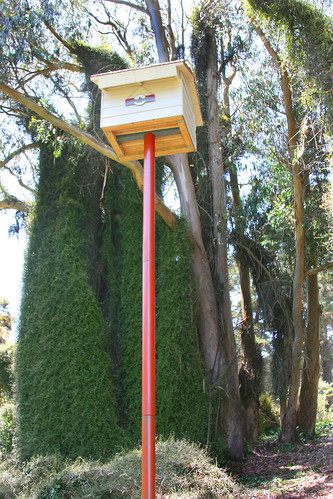
Chadwick Studio's "Habitat for Anna's Humminbird" was a nice arrangement of layered beds. The arrangement is based on the annual life cycle of the hummingbirds, but how exactly, is left to the imagination. Nearby is a lovely community vegetable garden with charming bird portraits pinned up in one corner.
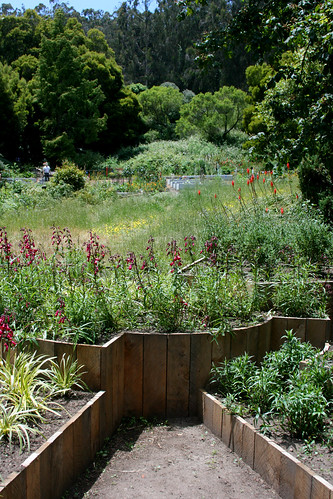
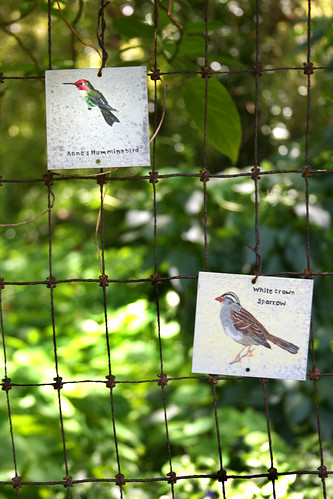
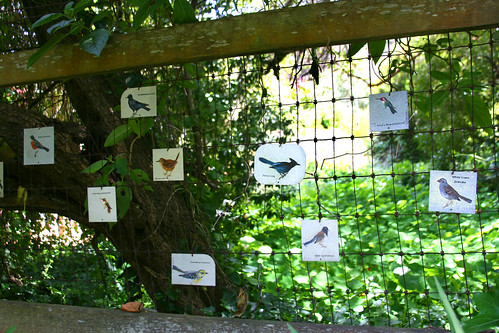
Amy Lambert's giant "Pollen Balls Project" looked amusingly out of place in the Presidio nursery's shade house. The large balls are meant to bring notice to the often overlooked Digger Bee. A solitary bee that digs tunnels, leaves behind one egg and a ball of pollen for sustenance. I also appreciated the repetition of the ball shape in the circular honeycomb of pots containing native seedlings for the park. Another well-placed sculpture.
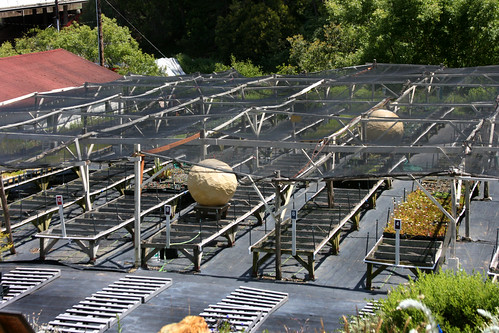
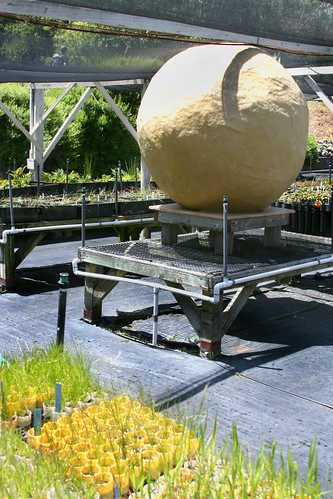
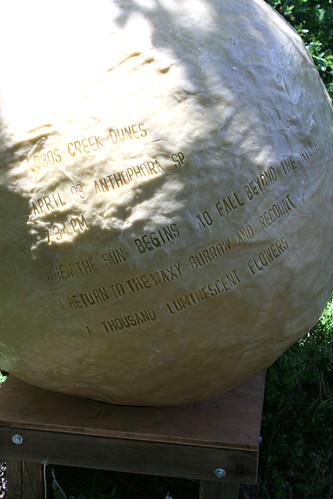
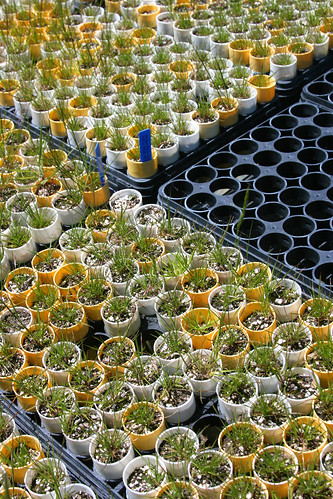

Lastly was Fritz Haeg's "Animal Estates Snag Tower", a slick looking condo tower for a variety of animals. A potential home for two kinds of birds, bees, bats, salamanders, and snakes.
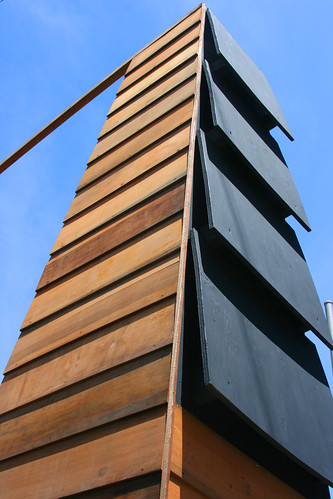
I couldn't help but wonder how many of these structures will be inhabited over the next year? In many of the descriptions, the animals associated with these structures are no longer found in the Presidio. So how will these be used? Who will live in them? I'm looking forward to going back in a few months to see what is happening with these habitats.
It was a beautiful day, one of the first warm and dry weekends of the year.

Land, sea and sky were all looking lovely that day.

The first piece was "Where is the Hare?" by Nathan Lynch. No longer found in the Presidio, the black-tailed jackrabbit is enticed by to the park by a promise of a can't-lose race. But I'd say the black-tailed jackrabbit is already a loser in our race for space.

The next installation is a grouping of yellow chairs around a meadow. Named "Patience" by Jensen Architects, the solitary seats encourage one to become as still and silent as the hunting blue heron and through the stillness of waiting and watching, one can know the environment more.

Next up is the Buckminster Fuller house for owls by Taalman Koch Architecture, aptly named "Owl Dome". Pretty hip owl pad.


The most minimal piece was Surface Design, Inc.'s "A Habitat of Flight". A single twisting band of steel represents the flight of a hawk over a large distance. Also built to be a perch for hawks but I didn't see anything high enough or with enough of a view, to please a hawk. It was hard to photograph, it shows up best in black and white.

The "Sculpture Habitat for the Grey Fox" by Cebra was pretty fun. I wanted to climb on it myself. Made from felled cypress trees in the Presidio, it has a beautiful way of fitting together. I look forward to seeing this again in a few months after it has aged and blends in more with its surroundings.

My favorite piece was by far "Winged Wisdon" by Philippe Becker Design, but then, as I've said before, I'm a sucker for words in the landscape. Three phases were interwoven into a grove of trees, half camouflaged, half unmissable. The steel mesh letters were stuffed with straw that will hopefully be used by birds in nestmaking. The first phrase I came upon was "resolve conflict with song". The site was wonderfully chosen since the tree-filled dell was filled with birdsong. The other two phrases were "nest from the inside out" and "adapt to change". Can't wait to see this one age as well.


Another owl habitat sculpture was Ai Weiwei's "Western Screetch Owl Habitat". Made of porcelain, the vessels felt very precarious and delicate hanging from the trees. I just hope they had drainage holes in case anyone does decide to nest in there.
The bat barracks of Mark Dion/Nitin Jayaswal's "Winged Defense" was a great allegory to not only the Presidio's military history but also reinforces the idea of bats as protectors of humans - protecting us from mosquitoes and mosquito-born illnesses. Well done, I salute thee.


Chadwick Studio's "Habitat for Anna's Humminbird" was a nice arrangement of layered beds. The arrangement is based on the annual life cycle of the hummingbirds, but how exactly, is left to the imagination. Nearby is a lovely community vegetable garden with charming bird portraits pinned up in one corner.



Amy Lambert's giant "Pollen Balls Project" looked amusingly out of place in the Presidio nursery's shade house. The large balls are meant to bring notice to the often overlooked Digger Bee. A solitary bee that digs tunnels, leaves behind one egg and a ball of pollen for sustenance. I also appreciated the repetition of the ball shape in the circular honeycomb of pots containing native seedlings for the park. Another well-placed sculpture.





Lastly was Fritz Haeg's "Animal Estates Snag Tower", a slick looking condo tower for a variety of animals. A potential home for two kinds of birds, bees, bats, salamanders, and snakes.

I couldn't help but wonder how many of these structures will be inhabited over the next year? In many of the descriptions, the animals associated with these structures are no longer found in the Presidio. So how will these be used? Who will live in them? I'm looking forward to going back in a few months to see what is happening with these habitats.

Gorgeous pictures! And so fun to be able to see this, when the only other way is to LIVE out in your area.
ReplyDeleteThank you for taking us on the "tour" with you!